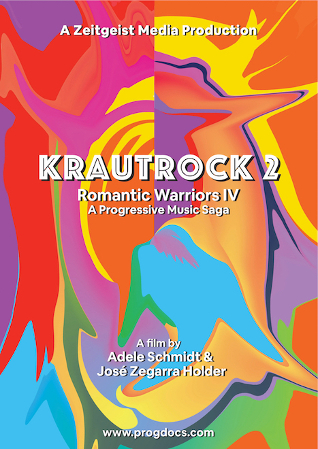
Krautrock 2 2021
Distributed by Zeitgeist Films, 247 Centre Street, New York, NY 10013; 212-274-1989
Produced by Adele Schmidt, José Zegarra Holder, Doug Curran, Jurriaan Hage, Jonathan Jarrett, and Peter Viek
Directed by Adele Schmidt and Jose Zegarra Holder
Streaming, 123 mins
College - General Adult
History; Progressive Rock Music; Protest Movements
Date Entered: 03/28/2022
Reviewed by Bryan J. Sajecki, University at BuffaloThe 1960s and 1970s were turbulent times across the world. The tense environment led to revolutionary attitudes, especially regarding politics and society. This was especially prominent in Western and Southern Germany, as the country was still dealing with the post-World War II climate. Leftist protests and hippies were agitating and lobbying for changes. This agitation pervaded the underground rock music scene of the time, evolving the sound to something relatively unknown beyond Europe. The phenomenon became what is known as “Krautrock.” With the second film of a trilogy, Krautrock (Part 2) analyzes and highlights eight specific bands of the movement and dives into how each group influenced the evolution of music in the nation and beyond.
The film begins by mentioning Essener Songtag, a leftwing musical festival organized by Rolf-Ulrich Kaiser in 1969. Kaiser invited whom he thought to be the best and most influential rock bands of the time in Germany, ushering in the beginning of a cosmic “German Invasion.” As the film progresses, director/producers Adele Schmidt and Jose Zegarra Holder combine present day interviews of band members alongside old footage of performances to showcase each band. The viewer quickly begins to see commonalities between each group, such as the influence of Anglo-American rock bands as well as funk, jazz, and soul musicians. Beyond the sonic influences, most acts were extremely moved by creating sounds with technology and using psychotropic drugs, predominantly LSD. Despite the parallels each band shared, they all managed to sound different, further demonstrating how “Krautrock” was not a genre, but more so a movement.
Music is a strange language that has the power to bring people together, no matter what it sounds like. Krautrock (Part 2) is another example of how musical movements are often the impetus of unsettled feelings, emotions, and unrest. As Mani Neumeier of Guru Guru remarked, the movement came from a need. Only the bands can correctly identify what they needed, and if they were ultimately satisfied.
This film provokes the viewer to open their mind and examine how art imitates real life. It would be a thoughtful addition to music libraries or academic libraries with strong programs in European and German history. Viewers should be aware of some use of vulgar language and descriptions of drugs and drug use.
Awards: Sajeta Art & Music Festival, Official Selection
Published and licensed under the Creative Commons Attribution 4.0 license. Anyone can use these reviews, so long as they comply with the terms of the license.